With careful observation of the leaves, a person can often diagnose health problems in hydrangeas. After diagnosing the problem, one can look for a solution for a healthier and happier hydrangea.
Here are 5 common hydrangea leaf problems:
- Brown Spots on Hydrangea Leaves
- Hydrangea Leaves Turning Yellow
- Edges of Hydrangea Leaves Turning Brown
- Hydrangea Rust
- Powdery Mildew on Hydrangea Leaves
1. Brown Spots on Hydrangea Leaves
In a home landscape, brown spots on the leaves are usually caused by a fungus or bacteria. In most cases, the fungus or bacteria does not threaten the life of the plant, but the spots can be unattractive. These spots usually appear annually toward the end of the summer and fall. The following spring, the leaves emerge unaffected, and the spots from the previous year do not affect the plant’s ability to bloom.
Fungal Leaf Spots on Hydrangea Leaves
There are two types of fungal diseases can infect hydrangeas - cercospora leaf spot and anthracnose.
1a. Cercospora Leaf Spot (also known as Cercospora hydrangea), is typically brown or purple colored spots at the base of the plant. The spots are small that typically measure 1/8 to 1/4 inches in diameter. Spots on the hydrangea macrophylla will sometimes have tan or gray centers with brown or purple border halos. When infected, the leave might turn yellowish then fall off. Sometimes entire hydrangea leaves will turn purple as well.

1b. Anthracnose is caused by the fungus Colletotrichum gloeosporioides. This produces large brown spots with lighter brown or tan centers in the spots. The spots may also appear on the flowers, which is a sign that the type of leaf spot is anthracnose.
Causal agents: Colletotrichum gloeosporioides, Colletotrichum dematium
Class: Sordariomycetes
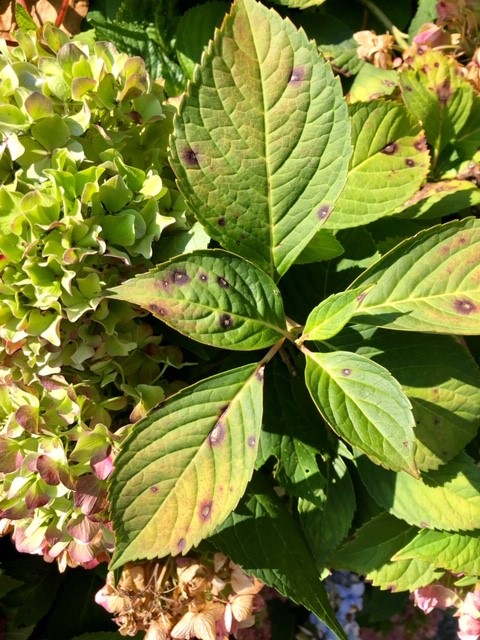
In most cases, fungus growing on hydrangea leaves will not kill the plant. However, in some cases Anthracnose can be fatal to hydrangeas.
Bacterial Leaf Spots on Hydrangea Leaves
Leaf spots on hydrangeas caused by bacteria are from the pathogen Xanthomonas campestris. Similar to cercospora, this will typically start at the base of the plant on the lower leaves, and will be either purple or red in color. The spots by the veins will become angular. This type of bacteria primarily impact Hydrangea quercifolia, arborescens and macrophylla.
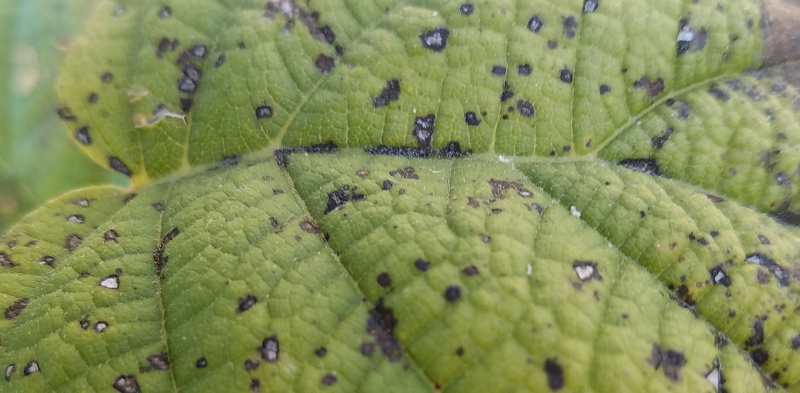
How To Treat Brown Spots on Hydrangeas
Fungicides can be applied, but most home gardeners do not feel this is a worthwhile option. You can help control brown spot by keeping the ground under the hydrangea free from leaf debris and by occasionally cutting off the old stems to allow air to circulate through the plant. Also, if your hydrangea has bloomed heavily during the summer, removing the dried blooms that are lying on the leaves may help to increase air circulation to the plant.
Natural Treatment For Leaf Spot on Hydrangeas
There are some all natural methods to treat leaf spot on hydrangeas. These include spraying infected leaves with:
- Compost Tea
- Liquid Kelp
- Garlic Oil
- Hydrogen Peroxide
To apply these natural remedies, use as directed on the bottle. For hydrogen peroxide, mix 1 ounce with 8 ounces of water in a spray bottle and spray on the leaves.
We also recommend removing all diseased and dead leaves off of the plants, to help prevent the spread of the leaf spot.
Chemical Treatment For Leaf Spot on Hydrangeas
Fungicides should be applied late in the spring to mid-summer. The most effective fungicides for hydrangeas are chlorothalonil and thiophanate-methyl. Those both help remove fungus caused by cercospora and anthracnose. Use as directed on the label of each bottle. Usually it needs to be applied every 10 to 14 days. Sometimes for more severe cases, you may apply more often.
2. Hydrangea Leaves Turning Yellow
During the growing season (the spring or the summer) if hydrangea leaves unexpectedly turn yellow and then brown and begin to fall off, a problem with the roots is usually the cause. This most often occurs before the plant has had time to establish a deep, strong root system, for example when the hydrangea is still in the pot or soon after it is planted. The three most likely causes are:
(1) the plant has become too dry
(2) the plant has been kept too wet
(3) the plant has received too much fertilizer (for #3 see “Brown Leaf Edges and Tips” below).
Each of these issues can cause a part or all of the root system to die. When the roots are damaged the leaves will wilt and then may turn yellow and then brown. In addition to these symptoms, keeping the plant too wet can lead to root rot and even death.
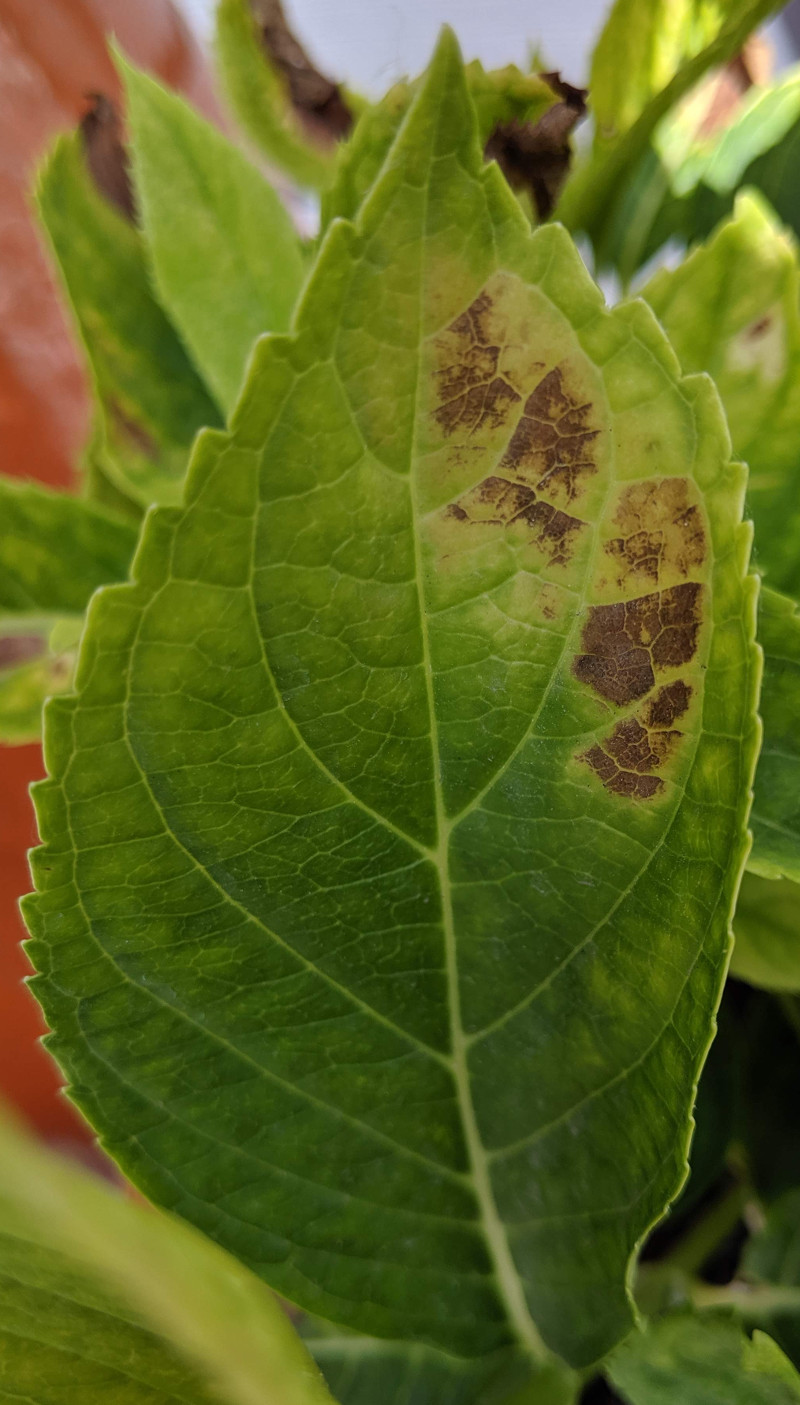
How To Treat Yellow Leaves on Hydrangeas
If a plant has been allowed to dry out, the first step to recovery is to thoroughly water the entire root ball. If it is still in a pot, try setting the plant in a tub of water up to the rim until the dry roots have been completely soaked. Then allow the hydrangea to drain freely. At his point, one’s instinct is to continue watering the plant to excess. However, it must be remembered that the roots are damaged, and they will be unable to deal with soil that it is too wet. So, allow time between each watering for the soil to dry out slightly and for the roots to regenerate.
3. Edges of Hydrangea Leaves Turning Brown
Hydrangeas growing in a pot or newly planted in the ground have roots that are especially vulnerable to strong applications of fertilizer. When one observes yellowing and browning leaf edges and leaf tips a day or two after the plant has been fertilized, the roots may have been burned. Aluminum sulfate, which is sometimes added to the soil to change the color of hydrangea blooms, also can cause root damage if applied too liberally.
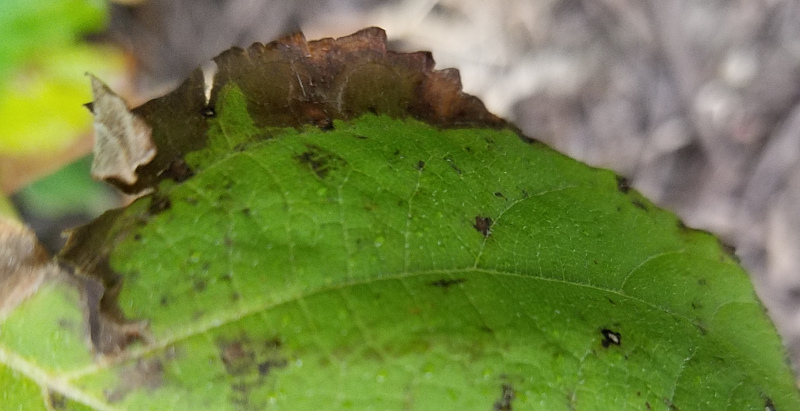
How To Treat Edges of Hydrangea Leaves Turning Brown
Thoroughly flush the hydrangea soil with water whether it is in a pot or in the ground. This should remove most of the salts from the soil. Then do not water the hydrangea for a day or two until the soil is slightly dry on the surface. Then water the plant as usual. If the hydrangea is grown in a container, make sure the water drains out the bottom of the pot after each watering. This will keep the salts flushed out on a regular basis (this applies to houseplants, too). After root-burn, do not fertilize again until the plant appears healthy, suggesting that it has developed a well-established root system.
Note: Never fertilize a plant that is not completely healthy!
4. Hydrangea Rust
Diagnosing this is relatively easy as hydrangea rust looks different than most other leaf problems. This is when the leaves develop orange spots on the underside of the leaves. This is a fungal disease where the spores spread in water. The leaves will eventually turn yellow or brown and fall off.
Causal agent: Pucciniastrum hydrangeae
Treating Hydrangea Rust
As mentioned above, this disease will spread due to water splashing on the leaves. This commonly happens when watering the plants. So when watering, be sure to spray the water towards the base of the plant while keeping the leaves above as dry as possible. You may also cut off the infected leaves if the problem isn’t severe. That will help prevent the rust from spreading. If the problem is severe, you may use a fungicide designed to treat rust. This is our favorite one below
5. Powdery Mildew on Hydrangea Leaves
This is another common problem that is easy to identify. Powdery mildew on hydrangeas will often look like a pale gray, powdery coating on the leaves. This is also a fungus that spread through spores. This typically happens during periods with hot days and cool nights. The large swings in temperatures help spread this disease.
Causal agents: Golovinomyces orontii (formerly Erysiphe polygoni), Erysiphe poeltii, Microsphaera friesii, Oidium hortensiae.
Treating Powdery Mildew on Hydrangea Leaves
The best way to treat this fungus is to remove any leaves or parts of the plant that have been infected. Unless the problem is so severe that you would have to remove entire sections of the plant. When watering, be sure to water the base of the plant. That will help keep the leaves dry and further spreading the fungus. Also, water in the morning so the leaves can dry out during the day and before the temperature drops at night. To kill the fungus, we recommend using an organic treatment like Neem. Use according to directions on the bottle.
Hydrangea Leaves After The First Freeze
No shrub has leaves that look as pitiful a hydrangeas' do after the first hard freeze. But this is natural and normal and, unless the freeze occurs after abnormally high temperatures, it should not harm the hydrangea at all. Hydrangeas grow and bloom best in areas where they can get at least a few freezes in the winter. So, unless one lives in a very cold climate, hydrangeas do not need to be covered when normal winter temperatures are experienced.
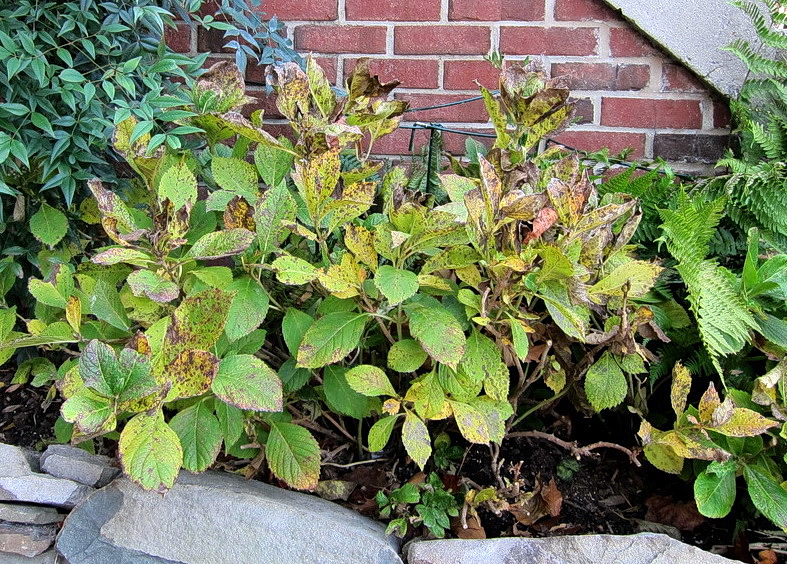
An exception to the rule of “no need to cover hydrangeas” occurs in the spring. If hydrangeas have already started putting out a few leaves or buds in the spring, and a frost is predicted, it would be prudent to cover a hydrangea with a breathable material before the freezing weather (this is only practical with small hydrangeas.) This action should help to protect the tiny emerging blooms. Once the sap starts rising in the stems of a hydrangea, the plant’s ability to withstand cold temperatures is greatly reduced. For more information, here is a helpful article about Protecting Hydrangeas in the Winter.
If you are noticing holes in the leaves, you could have a pest problem. For more information, here is a helpful article about Hydrangea Pests.
Hydrangea Leaves Drooping
This is typically caused by not enough water, and a clear signal that the plant needs to be watered soon. For more information, here is a helpful article about Watering Hydrangeas.
References:
Tennessee State University College of Agriculture, Human & Natural Sciences - Foliar Diseases of Hydrangeas, Dr. Fulya Baysal-Gurel, Md Niamul Kabir and Adam Blalock
New Jersey Agricultural Experiment Station - Disease Control Recommendations for Ornamental Crops, Ann Gould, 2012
Michigan State University Extension - Bacterial leaf spot on hydrangea, Jan Byrne, 2010
Missouri Botanical Garden - Bacterial spots, blights, and rots
 |
Author Chris Link - Published 8-04-2019 |
